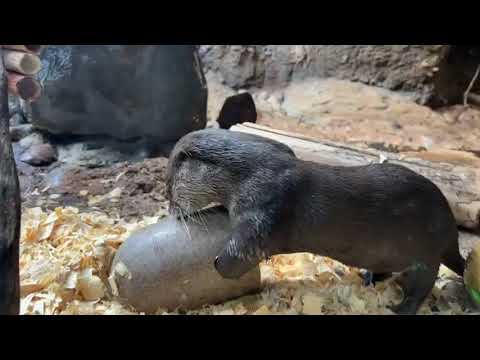–How Asian Small-Clawed Otters use their hands in ways that set them apart from their otter cousins.
-Delving into the fascinating social lives of these otters, known for their strong family bonds.
-Steps are being taken to preserve the habitats and populations of the Asian small-clawed otter.
-The relationship between these otters and humans, including challenges and successes in captivity.
Have you ever marveled at a pianist’s skill, fingers dancing over keys with precision and grace? Now, imagine these nimble movements not in a concert hall but below the rippling surface of a gentle stream in the verdant corners of Asia. Here lies the habitat of a creature less known for its musical prowess and more for its tactile acumen. Let’s dive into the world of the Asian Small-Clawed Otter – Aonyx cinerea.
In the vast family of the Mustelidae, which includes wolverines, badgers, and other otters, the Asian Small-Clawed Otter has carved out a niche as a master of touch. Unlike their relatives, who primarily utilize their olfactory senses to navigate and forage, these otters have evolved to employ their hands as their primary exploration tool. Their paws become their eyes in the murky waters where visibility is scant.
These aquatic ballerinas fit their hands into the nooks and crannies of the stream bed, tap-tapping along the surfaces like a prospector panning for gold. Each movement is intentional, calculated – feeling for the slightest movement, the subtle indication of life hidden beneath. They are searching for sustenance, their diet an eclectic mix of clams, shrimp, fish, and, for the particularly adventurous palate, live crickets – a veritable smorgasbord gleaned from the benthic buffet.
Their claws, it must be noted, are not the mighty tools of excavation you may find on a sea otter. They are short, almost unnoticeable, lending the paws a heightened sense of touch and an almost human-like dexterity. What they lack in digging prowess, they make up for in sensitivity. This adaptation is not just for foraging but for interacting with their world and each other.
The social sphere of the Asian Small-Clawed Otter echoes our notions of family dynamics. They live in large, interconnected families with bonds that would make even the tightest-knit human families envious. They play, groom, and communicate with a complex series of vocalizations ranging from chirps to whistles, each utterance a thread in the rich tapestry of their community.
In these families, young otters are tended to by their mothers and the collective. It’s a village raising these young otters to understand the subtleties of their world, teaching them the way of the paw – a framework that underpins their very survival.
But, as with many splendid creatures, the Asian Small-Clawed Otter’s existence is threatened. Their home, swoops of forests, and networks of clean streams yield to the ever-encroaching hand of human development. Wetlands are drained, rivers are polluted, and fish stocks are depleted. It is a story we know all too well – a repeating stanza in the ode to our planet’s biodiversity.
Conservationists are not sitting idly by, however. Protected areas, captive breeding programs, and education campaigns are just some measures being implemented. Zoos across the globe play their part by focusing on research and increasing public awareness. Captive populations act as ambassadors – a sort of foreign exchange program with the wild – offering insights into their behavior and biology that may be the key to their conservation.
These efforts offer a glimpse of hope, a chance for the symphony of the streams to continue unabated. As an audience both captivated and responsible, we must ensure that the performance does not end and that this delicate creature’s dance does not bow to a premature curtain.
Humans have a unique relationship with these otters. In some regions, they have been domesticated, partnered with fishermen to drive fish into nets – a centuries-old partnership. Yet, in captivity, the story can be bittersweet. While many thrive and teach us so much, some struggle in environments unlike their native homes. Here, zoos and aquariums bear a considerable responsibility – to provide shelter and a semblance of the streams and forests these otters call home. Enrichment is key, mimicking the complexity of their natural habitats to keep those curious paws and minds busy.
We’ve gazed into the eyes of these creatures, seen them at play, and witnessed their remarkable talent. In them, we see a slight reflection of our curiosity, our need to touch, feel, and understand our world.
Let’s return, for a moment, to that pianist, fingertips fluttering across the keys. Each note is an articulation, an echo of something greater. The Asian Small-Clawed Otter performs its kind of concert with each tap of its paws, rippling in the water and chirping among the group. Theirs is a song of survival, a melody woven through the wetlands of Asia, a harmony with nature that we, as their audience, must strive to preserve.
The stage is set for us to act, to be part of their narrative – not as silent observers but as contributors to a legacy that stretches beyond our own. And so, as the soft applause of otter paws against the water fades into the background, let’s ensure it’s merely the quiet before the next act and not the end of an unforgettable performance.
*****
Source Description
Asian small-clawed otters like to explore their environment with their hands rather than their noses like other otter species. They tap and feel around in the water and on land to forage for food like clams, shrimp, fish, and live crickets.


